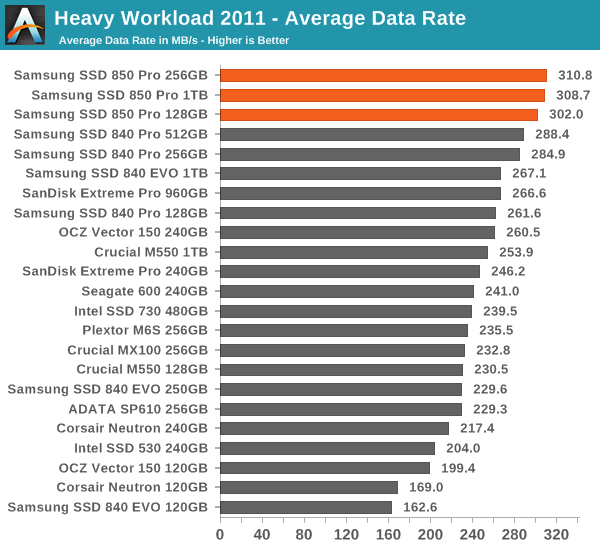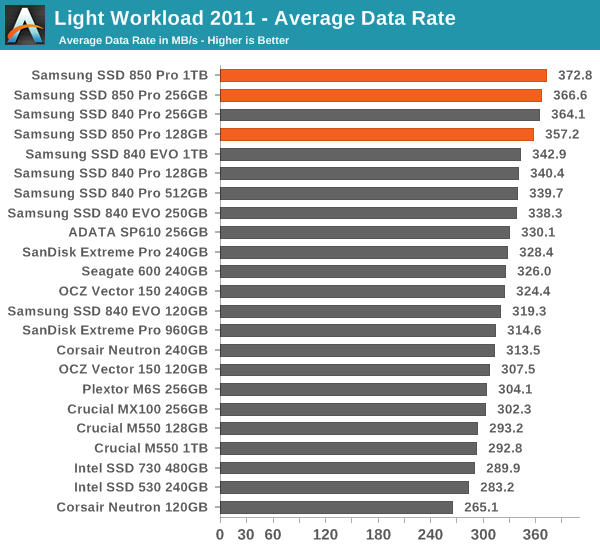Samsung SSD 850 Pro (128GB, 256GB & 1TB) Review: Enter the 3D Era
by Kristian Vättö on July 1, 2014 10:00 AM ESTAnandTech Storage Bench 2011
Back in 2011 (which seems like so long ago now!), we introduced our AnandTech Storage Bench, a suite of benchmarks that took traces of real OS/application usage and played them back in a repeatable manner. The MOASB, officially called AnandTech Storage Bench 2011 - Heavy Workload, mainly focuses on peak IO performance and basic garbage collection routines. There is a lot of downloading and application installing that happens during the course of this test. Our thinking was that it's during application installs, file copies, downloading and multitasking with all of this that you can really notice performance differences between drives. The full description of the Heavy test can be found here, while the Light workload details are here.

The dominance continues in our 2011 Storage Benches. The 840 Pro was already the fastest drive in both suites, so it does not come as a surprise that the 850 Pro takes the lead.











160 Comments
View All Comments
YazX_ - Monday, July 7, 2014 - link
Prices are not going down, good thing we have Crucial who have best bang for the buck, ofcourse performance wise is not compared to sandisk or samsung, but its still a very fast SSD, for normal users and gamers, Mx100 is the best drive you can get for its price.soldier4343 - Thursday, July 17, 2014 - link
My next upgrade the Pro 850 512gb version over my OCZ 4 256gb.bj_murphy - Friday, July 18, 2014 - link
Thanks Kristian for such an amazing, in depth review. I especially loved the detailed explanation of current 2D NAND vs 3D NAND, how it all works, and why it's all so important. Possibly one of my favourite Anandtech articles to date!DPOverLord - Wednesday, July 23, 2014 - link
Looking at this it does not seem to be a HUGE difference than raid 0 of 2 Samsung Pro 840 512GB (1tb in raid 0).To upgrade at this point does not make the most sense.
Nickolai - Wednesday, July 23, 2014 - link
How are you implementing over-provisioning?joochung - Tuesday, July 29, 2014 - link
I don't see this mentioned anywhere, but were the tests performed with RAPID enabled or disabled? I understand that some of the tests could not run with RAPID enabled, but for those other tests which do run on a formatted partition (i.e. not run on the raw disk), its not clear if RAPID is enabled or disabled. Therefore its not clear how RAPID will affect the results in each test.Rekonn - Wednesday, July 30, 2014 - link
Anyone know if you can use the 850 Pro ssds on a Dell PERC H700 raid controller? Per documentation, controller only supports 3 Gb/s SATA.janos666 - Thursday, August 14, 2014 - link
I always wondered if there is any practical and notable difference between dynamic and static over-provisioning.I mean... since TRIM should blank out the empty LBAs anyway, I don't see the point in leaving unpartitioned space for static over-provisioning for home users. From a general user standpoint, having as much usable space available as possible (even if we try to restrict ourself from ever utilizing it all) seems to be a lot more practical (until it's actually usable with an acceptable speed, so even if notably slower but still fast enough...) than keeping a (significantly more, but still not perfectly) constant random write performance.
So, I always create a system partition as big as possibly (I do the partitioning manually: a minimal size EFI boot partition + everything else at one piece) without leaving unpartitioned space for over-provisioning and I try to leave as much space empty as possible.
However, one time, after I filled my 840 Pro up to ~95% and I kept it like that for 1-2 days, it never "recovered" . Even after I manually ran "defrag c: /O" to make sure the freed up space is TRIMed, sequential write speeds were really slow and random write speeds were awful. I ha to create a backup image with DD, fill the drive with zeros a few times and finally run an ATA Secure Erase before restoring the backup image.
Even though I was never gentle with the drive (I don't do stupid things like disabling swapping and caching just to reduce it's wear, I bought it to use it...) and I did something which is not recommended (filled almost all the user-accessible space with data and kept using it like that for a few days as a system disk), this wasn't something I expected from this SSD. (Even though this is what I usually get from Samsung. It always looks really nice but later on something turns out which reduces it's value/price from good or best to average or worse.) This was supposed to be a "Pro" version.
stevesy - Friday, September 12, 2014 - link
I don't normally go out of my way to comment on a product but I felt this product deserved the effort. I've been using personal computer since personal computers first came out. I fully expected my upgrade from an old 50gig SSD to be a nightmare.I installed the new 500gig Evo 850 as a secondary, cloned, switch it to primary and had it booting in about 15 minutes. No problems, no issues, super fast, WOW. Glad Samsung got it figured out. I'll be a lot less concerned my next upgrade and won't be waiting until I'm at my last few megabytes before upgrading again.
basil.bourque - Friday, September 26, 2014 - link
I must disagree with the conclusion, "there is not a single thing missing in the 850 Pro". Power-loss protection is a *huge* omission, especially for a "Pro" product.